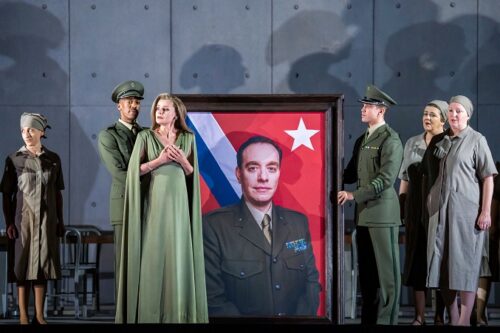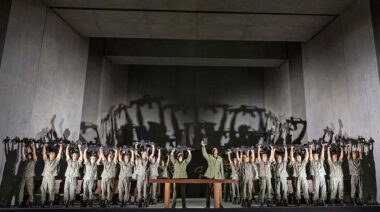 United Kingdom Verdi, Aida: Soloists, Chorus and Orchestra of the Royal Opera House / Sir Antonio Pappano (conductor). Broadcast (directed by Peter Jones) to Cineworld Basildon, Essex, 12.10.2022. (JPr)
United Kingdom Verdi, Aida: Soloists, Chorus and Orchestra of the Royal Opera House / Sir Antonio Pappano (conductor). Broadcast (directed by Peter Jones) to Cineworld Basildon, Essex, 12.10.2022. (JPr)

Production:
Director – Robert Carsen
Set designer – Miriam Buether
Costume designer – Annemarie Woods
Lighting designers – Robert Carsen and Peter van Praet
Choreographer – Rebecca Howell
Video designer – Duncan McLean
Chorus director – William Spaulding
Cast:
Aida – Elena Stikhina
Radames – Francesco Meli
Amneris – Agnieszka Rehlis
Amonasro – Ludovic Tézier
Ramfis – Soloman Howard
King of Egypt – In Sung Sim
Messenger – Andrés Presno
High Priestess – Francesca Chiejina
The two cinema broadcasts I have seen this season have had informed and informative presentations introduced by Elle Osili-Wood who began by saying how in Robert Carsen’s new Aida production, ‘His backdrop is a place never named but one in which we recognise elements of America, China and Russia. The vast hall and bunker-like sets are filled with rows of soldiers and weapons. It is a far cry from the traditional palaces and pyramids we associate with this classic opera.’
It was good to have Carsen, himself, interviewed to explain: ‘When you come to direct something you have to figure out what it’s about, and the plot or the story of the opera is not necessarily what the actual opera is about. In this case … I came to realise quite quickly both the background and the foreground of the story of Aida are, is, war. And that is when we realise that in order to bring that out, we have to leave out the picturesque side of this. I mean the Egyptian background is beautiful, but it is very difficult for us to connect to that today and since the characters talk all night long about war, death, patriotism, nationalism, it felt necessary given the present context … it seemed important for our modern world to take a modern take on this piece.’ He then continued, ‘Actually, if we are taking this away from Egypt it is better not to place it, transfer it, exactly to an identifiable country or countries but to allow it to involve different elements of the world, unfortunately because war is still ever-present.’
An Aida in Vienna – too many years ago than I care to remember – was the opera that gave me the first frisson that I hope for every time I return to an opera house. There, the Act II procession came from upstage and seemed to go on for ever. My first Aida at Covent Garden in 1977 had a handful of extras running round behind the set and returning – to their increasing exhaustion, if I remember correctly – waving a different banner. Here it was simply the veneration of the fallen whose coffins were lined up at the front of the stage and whose faces were displayed at the back.
Carsen’s Konzept worked for me especially with the war between Ukraine and Russia in the news headlines every day; although it needn’t have been Aida and could have been any of Verdi’s explorations of the individual, love, power, politics and religion. Soldiers are mostly in Annemarie Woods’s army fatigues, service uniforms or bemedaled dress uniforms in colours that are mostly grey (matching Miriam Buether’s set), khaki, green or blue. In Act I we firstly see the king venerated in a vast hall before there is a religious service when Radames – conflicted by his love for the enslaved Aida, actually the daughter of the enemy’s king – is announced as commander-in-chief. The soldiers in pews are brandishing their automatic weapons and there is some haunting shadow play at the end of the act. The second act begins with Amneris (the king’s daughter) having a large photo of Radames hung on the wall and a huge table across the stage is laid for a victory dinner. While we hear much dance music the only choreography there is involves some calisthenics (from Rebecca Howell) for a military elite to the delight of the soldiers sitting on tiered rows of seating, along with Ramfis (here the highest-ranked army officer), the King and Amneris, and all bookended with flags. The act ends with video designer’s Duncan McLean projected images of war.

Act III is dominated by the memorial wall to those who fell in battle at the rear and an eternal flame at the front. The final act returns to us to where we were in Act II for Radames’s court-martial, and he is denounced by his comrades onstage (rather than off as it is mostly performed if priests are involved). The opera ends in an underground bunker full of missiles and the dying Aida and Radames just retreat into darkness. (Just a small misstep by Carsen for me and perhaps the budget did not run to having the doomed lovers in a silo strapped to a missile being readied for launch?) Finally, the stage lights up and leaves us with the thought-provoking image of missiles pointing out towards us watching wherever we were in the world. At this point Amneris sings ‘Peace, peace, peace’!
In this threatening atmosphere the Aida-Radames-Amneris love triangle plays out. Carsen only allows Elena Stikhina’s Aida flashes of the princess she is, dowdily costumed she knows her place as Amneris’s dogsbody. Her ‘Ritorna vincitor!’ revealed all you needed to know about how conflicted her character is about love for Radames and love of her country. The steely resolve was self-evident but, as heard through cinema loudspeakers, there was something lacking in Stikhina’s voice and I never really felt the sympathy for Aida’s plight that I have with some other sopranos. Francesco Meli seems to be the go-to tenor these days as Radames and he sang sturdily enough attempting diminuendo after diminuendo beginning with the ending of ‘Celeste Aida’. He was somewhat exposed by Peter Jones’s closeup camerawork and was shown – once again – not to be as good an actor as most of those on the stage with him. Agnieszka Rehlis, making her Covent Garden debut, was the outstanding performer in this Aida not so much in the way she acted but the way she reacted to everything going on around her. She waivered brilliantly from unrequited love to unyielding jealousy to her desperation to save Radames’s life. Rehlis will be a hard act to follow, even by Elīna Garanča when there are further performances next May.
The Chorus of the Royal Opera House – splendidly drilled by their chorus director William Spauling – impressed throughout both with their stentorian power and quiet a cappella singing. They were undoubtedly helped by singing mostly in serried rows within a box-like set. Ludovic Tézier’s slightly gruff, though sonorous, singing was entirely appropriate for Aida’s vengeful father Amonasro. Ramfis was imposingly sung by Solomon Howard who has great stage presence, whilst In Sung Sim as the King had the low notes and the gravitas the role demands.
Antonio Pappano conducted an expressive, beautiful sounding account of the score drawing nuanced virtuosity and exquisite colours from his excellent Royal Opera House Orchestra, and it was significant that there were no longueurs since tension never slackened.
Undoubtedly an Aida for the twenty-first century which conveniently glosses over the optics created by a ‘traditional’ approach that need no discussion here.
Jim Pritchard
